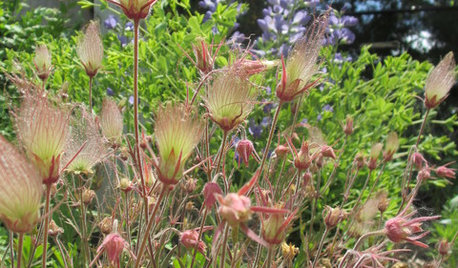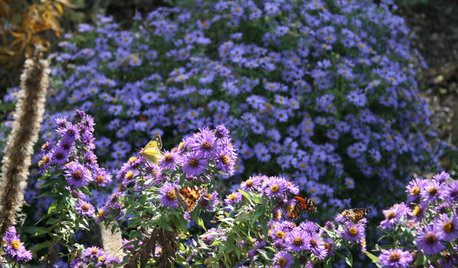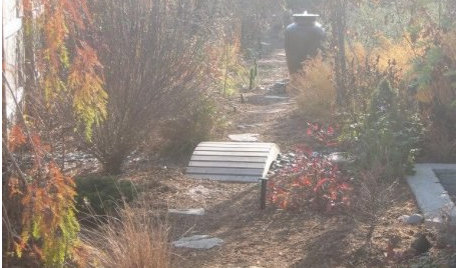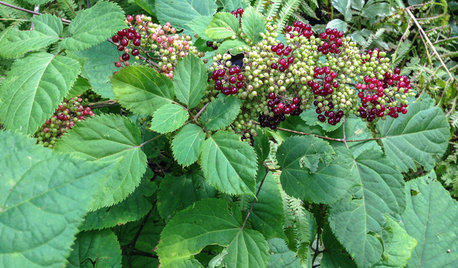to stratify or not that is the question
I'm doing a little research and learning from Gardenweeds spreadsheet flowers that need cold stratified and those that don't.
I have copied a list for you all here, however, I would suggest doing a cross reference on a plant if you really want to know.
Such as I've read Echinacea Purple cone flower likes a period of 60-90 days cold stratification however, most sorces say Ech. does not need stratified, what do you think?
Another Liatris Blazing Star - Gayfeather, there seems to be mixed opinions. the website I'm going to post seems to think many of our perennials do not need stratified. If you have a different opinion please shout it out, lets all get on the same page.
Here's the site:
http://www.perennials.com/seehowto.html?item=11
EASY GERMINATORS: These seeds are great ones to get started with, especially if you plan to sow seeds indoors under lights. None require any special cold treatment. Just sow as for tomatoes or peppers but allow 6 to 12 weeks for germination:
Achillea (Yarrow), Alcea (Hollyhock), Alyssum (Perennial Alyssum), Anthemis (Perennial Marguerite), Aquilegia (Columbine), Arabis (Wall Cress), Armeria (Thrift), Aster, Aubrieta (Rock Cress), Aurinia (Basket-of-Gold), Bellis (English Daisy), Campanula carpatica, Campanula persicifolia (Bellflower), Catananche (Cupid's Dart), Centaurea (Cornflower), Centranthus (Red Valerian), Cerastium (Snow-in-Summer), Coreopsis (Tickseed), Cynara (Cardoon, Globe Artichoke), Dianthus (Pinks, Carnations, Sweet William), Digitalis (Foxglove), Doronicum (Leopard's Bane), Echinacea purpurea (Purple Coneflower), Echinops (Globe Thistle), Erigeron (Fleabane Daisy), Erysimum allionii (Siberian Wallflower), Gaillardia (Blanket Flower), Geum (Avens), Gypsophila (Baby's-Breath), Helenium (Helen's Flower), Hesperis (Dame's Rocket), Heuchera (Old-fashioned Coral Bells), Kniphofia (Torchlily), Leucanthemum (Shasta Daisy), Liatris (Blazingstar), Limonium (Sea Lavender), Linum perenne (Blue Flax), Lunaria (Money Plant, Silver Dollar), Lupinus (Lupine, best sown directly outside in late spring), Lychnis (Campion), Malva (Mallow), Monarda (Beebalm), Myosotis sylvatica (Forget-me-not), Origanum (Oregano), Papaver (Poppy), Physostegia (Obedient Plant), Polemonium (Jacob's Ladder), Potentilla (Cinquefoil), Rudbeckia hirta (Gloriosa Daisy), Salvia (Perennial Sage), Stachys (Lamb's Ears), Tanacetum (Painted Daisy, Feverfew), Thymus serpyllum (Mother-of-Thyme), Verbascum (Mullein), Verbena, Veronica most tall types (Speedwell), Viola hybrids (Winter Pansy).
FOR ADVANCED SEED STARTERS ONLY: These seeds are trickier to handle. Many are tiny, and most require a special cold treatment or absolutely nothing will happen. See the germination link above for specific details:
Acanthus (Bear's-Breeches), Aconitum (Monkshood), Alchemilla (Lady's Mantle), Alstroemeria (Peruvian Lily), Anemone (Windflower), Angelica, Arum, Aruncus (Goat's Beard), Asarum (Wild Ginger), Asclepias (Milkweed), Astrantia (Masterwort), Baptisia (False Indigo), Bergenia, Buddleia (Butterfly Bush), Caltha (Marsh Marigold), Caryopteris (Bluebeard), Chelone (Turtlehead), Chrysogonum (Golden Star), Cimicifuga (Bugbane), Clematis, Corydalis (Fumitory), Crambe (Seakale), Cyclamen, Delphinium, Dicentra (Bleedingheart), Dictamnus (Gas Plant), Dodecatheon (Shooting Star), Eremurus (Foxtail Lily), Eryngium (Sea Holly), Eupatorium (Boneset), Euphorbia (Spurge), Filipendula (Meadowsweet), Fuchsia, Gaura (Butterfly Gaura), Gentiana (Gentian), Geranium species (Cranesbill Geranium), Goniolimon (German Statice), Gunnera, Helianthemum (Rock Rose), Helianthus (Perennial Sunflower), Heliopsis (False Sunflower), Helleborus (Christmas & Lenten Rose), Heuchera hybrids (Fancy-leaf Coral Bells), Hibiscus (Hardy Hibiscus), Hypericum (St. John's-Wort), Iberis (Perennial Candytuft), Incarvillea (Hardy Gloxinia), Iris species, Jasione (Shepherd's Bit), Kirengeshoma (Waxbells), Knautia (Crimson Scabious), Lathyrus (Perennial Sweet Pea), Lavandula (Lavender), Lavatera (Tree Mallow), Leontopodium (Edelweiss), Lewisia, Ligularia, Lobelia, Lysimachia (Loosestrife), Macleaya (Plume Poppy), Mazus (Creeping Mazus), Mertensia (Virginia Bluebells), Myrrhis odorata (Sweet Cicely), Nepeta (Catmint), Oenothera (Evening Primrose, Sundrops), Omphalodes (Naval-seed), Penstemon (Beard-tongue), Perovskia (Russian Sage), Persicaria (Fleeceflower), Phlomis, Phlox (all types), Physalis (Chinese Lantern), Platycodon (Balloon Flower), Podophyllum (May Apple), Primula (Primrose, all types), Pulsatilla (Pasque-flower), Ranunculus (Buttercup), Ratibida (Prairie Coneflower), Rheum (Rhubarb), Rodgersia, Rosmarinus (Rosemary), Rudbeckia (Black-eyed Susan, most types), Rumex sanguineus (Bloody Dock), Sanguinaria (Bloodroot), Sanguisorba (Burnet), Saponaria (Soapwort), Saxifraga (Saxifrage), Scabiosa (Pincushion Flower), Sedum (Stonecrop), Sempervivum (Hen-and-Chicks), Sidalcea (Prairie Mallow), Silene (Campion, Catchfly), Sisyrinchium (Blue-eyed Grass), Stokesia (Stokes' Aster), Teucrium (Germander), Thalictrum (Meadow-rue), Tiarella (Foamflower), Tradescantia (Spiderwort), Tricyrtis (Toad-lily), Trollius (Globeflower), Vernonia (Ironweed), Veronica Dwarf Types (Speedwell), Veronicastrum (Culver's-root), Viola species types (Violets), Waldsteinia (Barren Strawberry), Zantedeschia (Calla Lily).
Here is a link that might be useful: Perennial germination
Comments (22)
micki
Original Author12 years agolast modified: 9 years agoanother one with mixed opinions is Shasta Daisies Leucanthemum/chrysanthemum.
Does it need cold stratified or not?
I say when there are two different answers stratify, so I will sow this one early with the others that need stratified.
Mickimicki
Original Author12 years agolast modified: 9 years agoThis is a PDF alphabetized by Latin names. I found it very informative. It was quick to scroll down to the plant I needed a quick description on and propagation/germination details.
Here is a link that might be useful: Information on various plants
Related Professionals
Arnold Landscape Architects & Landscape Designers · Ballwin Landscape Architects & Landscape Designers · Norton Shores Landscape Architects & Landscape Designers · Seabrook Landscape Architects & Landscape Designers · East Patchogue Landscape Architects & Landscape Designers · Stoughton Landscape Contractors · Peabody Landscape Contractors · Brookline Landscape Contractors · Dallas Landscape Contractors · Gresham Landscape Contractors · Harrisburg Landscape Contractors · Lemont Landscape Contractors · Little Ferry Landscape Contractors · Mission Viejo Landscape Contractors · Pomona Landscape Contractorsoliveoyl3
12 years agolast modified: 9 years agolittleonefb - thanks for the reminder to keep WSing simple. I needed it!
Corrine
TraceyOKC
12 years agolast modified: 9 years agoUntil I got early sprouts I didn't even think about timing. Oops, rookie mistake. Fran, I like your simple version. Mikki, I am saving that PDF file for future ref. I was dreading having to research all my seeds...I would rather be playing in the dirt. :-)
morz8 - Washington Coast
12 years agolast modified: 9 years agoMikki, for a comprehensive list that's accurate, why don't you bookmark the Clothiers site for reference, lots of us use it. Most of the suggestions there are for commericial seeds, or seeds that have been allowed to dry and have been stored (unless noted). A nice balance to the Clothiers site is book Making More Plants by Druse where often the suggestions are for freshly harvested seed - between the two, very few things you may want to sow would be missing. Try Ebay for the Druse book, or even used on Amazon - better yet, check it out of your library and see how you like it, mine is out and on my desk all the time.
Here is a link that might be useful: Clothiers
TraceyOKC
12 years agolast modified: 9 years agoUntil I got early sprouts I didn't even think about timing. Oops, rookie mistake. Fran, I like your simple version. Mikki, I am saving that PDF file for future ref. I was dreading having to research all my seeds...I would rather be playing in the dirt. :-)
micki
Original Author12 years agolast modified: 9 years agoI think the keep it simple is a great idea too, Kinda what I was following at first, but then I wanted a little more.
Morz I will really appreciate this site and your book suggestions,
thank you everyone for responding.
Mickibeatrice_outdoors
12 years agolast modified: 9 years agoI think I may go by a more simple rule-if it's a seed, I winter sow it. If I have enough of them, I fall sow some of them. If mother nature dropped those annual seeds in the fall and did not intend for them to come up until spring, then that's good enough for me. If it does not come up...oh well.
I am also a fan of plunk-and-run planting a HOS.
KISS! (second S is silly...)
Beatricegardenweed_z6a
12 years agolast modified: 9 years agoI saved Clothiers as a favorite because even with my spreadsheet, I will often double check before I sow seeds and set the jug out in the cold. There are inconsistencies between what Swallowtail, Hazzard's and Clothiers say about a number of perennials. I sort of mentally toss a coin in those instances and, if in doubt, go with winter sowing. If I'm still not sure, I'll look on Diane's website for growing information. If she says refrigerate 4-6 weeks, out it goes no matter what the others say.
TraceyOKC - I do the research while I'm playing in the dirt so it doesn't bother me a bit!
kqcrna
12 years agolast modified: 9 years agoAnd what do you do if it doesn't need cold strat? Sow inside under lights?
I do pretty much as Fran does- perennials and hardy annuals in winter, annuals closer to spring. I also usually do a few select tender annuals inside under lights.
Karen
littleonefb
12 years agolast modified: 9 years agothat's what wintersowing is all about, easy, simple and fun.
Not all seeds are going to germinate, no matter how they are started and no matter where you got them from; commercial seeds, from the seed exchange here on GW and even if they where seeds that the "mother plant" dropped on the ground herself.
Some seeds just won't germinate no matter what you do, some seeds are not viable because they where not "ripe" seeds when collected, some seeds are just not viable period and sometimes, like life things just happen and they don't germinate.
The only other thing that is important is this crazy, crazy weather we are having now and have been having for the last several years.
Several years ago, we had an extremely warm Dec and Jan.; nothing like we are having this year, but really very warm.
I was afraid to start sowing because of the warm temps, fear that if it kept on long enough, then seeds would germinate and if we eventually got to normal temps and snow, I would lose the seedlings.I stalled on sowing, along with a friend that I WS with, and another friend, in the same town I live in, decided to start.
Less than 2 weeks after she put her seeds out, she started getting seeds germinating and in less than 4 weeks she had tons of seedlings in all 40 containers she put out.
Then the "real winter" hit and she lost all the seedlings as they where buried under 4 feet of snow for the next 2 months and bitter cold temps.
After that experience, my first "real" WS containers don't go out till the first week in Feb now.
I did compare with all my notes from prior years and whether the containers went out the end of Dec, any time in January, or not until the first 2 weeks in February, the seeds always germinated at the same time every year. within a week of the prior dates either before or after.Those seeds are going to germinate when the weather says to do it, and the only fear is if that weather decides that it is way to early to do so.
There's an old saying "you can't fool mother nature", and technically that is what we are trying to do, in part, with wintersowing.
We are providing those seeds with their own little "greenhouse" to keep them in one confined area to germinate, but combining mother nature to do the work for us after that part that we do.
The slight involvement that we have in the process is just enough to attempt to "fool mother nature" in the germination process. Those "greenhouses" that we put those seeds in, provides them with warmer soil temps than if they where on the ground and that throws off the seeds in telling them what to do.So after all that rambling from me, the best advise from experience is still the same, perennials out in the winter, my zone makes it the first 2 weeks in February, out they go, and the rest start to follow in the same order i listed above.
Temps like we have been having say, wait a bit longer to start and if you don't then save some of the seeds just incase and be safe.
But most of all, this is supposed to be an easy, fun process of starting seeds and having an abundance of seedlings of all different kinds in the spring.
Enjoy what you are doing and don't stress over it. Don't let it become an all consuming process and overwhelm you. Don't make it more difficult that it really has to be.
Make it simple, simple, simple and have fun.
Oh, never start any seeds under lights. If it doesn't work outside with wintersowing, spring sowing, summer sowing, fall sowing, then it just doesn't get sown and grow in my yard.
Though I do get plant divisions from various GW members that come to my annual plant swap.Rarely buy any plants at the nursery, except for my yearly purchase of rosemary. too gold to winter over outside, to dry inside to keep it through the winter inside.
And you bet "plunk and run" is the way to sow.
I'm reminded of a neighbor's young son who was helping me plant some of my seedlings about 5 years ago.
Amazing how sometimes, you get the best advise from a 3-4 year old.
He heard me moaning that we where "running out of room to plant all the seedlings in the garden beds" and I told him "I am going to have to make a new flower bed for next year".
Talk about having a very puzzled look on a kids face. He must have thought I was totally crazy. He got up off the ground and walked around the front yard, all over the lawn, kept looking down at the lawn, back at me, at all the seedlings left to plant and then came running back and got my little trowel he was using and a container of seedlings and ran off to the center of the yard and dropped down on the lawn and proudly yelled out.
"dirt, dirt, everywhere, dig a hole and plunk it in". then he started to dig a hole smack in the middle of the lawn.
Yup there's always room for more plants, always room for more flower beds, and always room to just "plunk" them in a hole in the dirt and squish them in somewhere.
Just let wintersowing be fun and enjoy the whole process.
Fran
gardenweed_z6a
12 years agolast modified: 9 years agoKaren - not sure that's directed at me but if it is, I winter sow the seeds and stick them out in the snow/cold. I research/look them up to see what information is out there about them in case I don't already know what they need + to make notes in my garden diary. I know winter sowing will take care of the stratification...I just like to know I'm in the ballpark when it comes to the seeds needing the cold. Sorry if I've misled anyone about that.
With winter sowing I don't get my tail in a knot about much and certainly don't worry about the seeds in the jugs outside in January whether the weather cooperates or not. If they germinate, I keep track of it. If they don't, I make a note of it.
I've never grown inside under lights--never had the space or the $$$. I've spent years trying to grow things from seed however and am always intrigued by whatever methods are put forward. Winter sowing was a hit with me right out of the gate and I'm enjoying my third year of worry-free sowing, getting my hands in dirt in winter and not having to explain what I'm doing to anyone. Most everyone knows I'm nuts to do this but since it works, I don't really give a hoot what they think.
Sounds like I've worn out my welcome here however so I'll step back and let the rest of you do your thing. I sure never meant to offend anyone or insinuate that I have some knowledge that transcends the experts. I'm just a gardener who'll keep on gardening.
kqcrna
12 years agolast modified: 9 years agoNo, no, no, gardenweed. I was just curious why the interest in strat need. If you're doing to do those not needing strat under lights, that's one possibility. But... and this is the big question mark for me... if they don't NEED strat and you put them out in January, no harm is done.
So, I'm wondering why you, and others, find the strat requirements important? It usually doesn't even cross my mind unless I'm sowing something in late spring or summer.
I didn't mean to criticize at all.
Karen
molanic
12 years agolast modified: 9 years agoI lookup the stratification requirements when I am making up my plant tags. Then I write on the tag "ws" for wintersow and "ss" for spring sow. If it is something that may need multiple warm cold warm cycles I also write on it "slow" and the date sown. That way if it isn't sprouted by summer I know to keep watering it and move it to a shady spot over the summer so it won't completely dry out before next winter.
I file my seed packets I plan to sow and prepared labels in a tub with sections for sowing early winter, late winter/spring, and tender-only sow after frost. This is just to make sure I get the things that NEED cold out first. Then I can take my time doing the things that might need a bit of cold or fluctuating temps or at last can handle cold. The tender things can wait, some of them get done in my "wintersowing containers" and some get direct sown. That decision depends on how many of the seed I have, where it is going, how quickly it germinates, and of course how much potting mix I have left! I always end up underestimating how much I am going to do each year.
So, there are still reasons why some of us research the seed's needs, but it is definitely not required for a successful experience. If you like researching that info - do it, if not skip it altogether or maybe just do it for those very special seeds. You will also learn what works best for you over the years and tweak the routine to suit your needs.
donn_
12 years agolast modified: 9 years agoI've always kept close track of the germination needs of the seeds I try to grow, primarily because I'm very interested in the various types of dormancy the seeds possess. I use Jelitto most often, because as the largest seed house in the world, they have the most species covered, and direct their instructions at professional growers more than casual gardeners. I've also used Clothier a bit, and have a copy of the TAMU PDF file on my desktop.
My feeling is the more I know about the plants I grow, the better. I've always kept strict records, from sowing, through germination, seedling stages, planting, pruning, dividing, moving, etc.. You just can't have too much information.
mnwsgal
12 years agolast modified: 9 years agoI also like to know which seeds need stratification, mostly because one year I started some seeds too close to spring that did not germinate. When I learned they needed more time to stratify I kept the jug and had germination the next year. I'm sure I discarded containers the first two years because I had not given them the time needed. Ah, one learns.
Like Donn, I use various sources, including a post he made one year of seeds that need stratification. Most seeds do not need stratification but with sowing hundreds of varieties at a time, many of which I are new to me, some require special attention to meet their germination needs.
morz8 - Washington Coast
12 years agolast modified: 9 years agoSeveral of you are giving me a painful reminder that I need to improve my record keeping skills, become more disciplined.
It used to work to trust much to memory - now, not so much. That pot I quickly prepared and sat out with some things on my porch the other week, with no label because I was only doing the one that day and would know what I'd done....
Any guesses anyone, because I'm drawing a total blank and the pot is giving me no clues at all :)
highalttransplant
12 years agolast modified: 9 years agoMy strategy is similar to molanic's. I print out a spreadsheet each year, of everything I plan to sow. There is a column for germination method. Everything gets marked either - WS for winterow, SS for spring sow, DS for direct sow, or SI for sow indoors. That way when it comes time to sow, I can just grab the seeds that apply to whichever method I am about to use.
Morz8 - I quit trusting my memory a looong time ago, LOL.
Bonnie
barbe_wa
12 years agolast modified: 9 years agoI like to know what needs stratification so I can sow those seeds first. I sow a lot of jugs and it's easy to overlook some until it's too late. Like highalttransplant, I keep a spreadsheet with the method of sowing marked. I'm in my 70's and my memory just isn't adequate anymore.
val (MA z6)
7 years agoExcellent info everyone! I've been wintersowing for 2 yrs..this will be my first. Some things have done better than others for me, but I always seem to have tons of seedlings to plant :D
mnwsgal
7 years agolast modified: 7 years agoIME sowing many of the ones on the advance list are just as simple as the easy germination list. Even beginners can sow those advanced ones by keeping in mind that some need cold stratification and some take two years or more to germinate so don't throw out the jug the first spring. Good suggestions in the replys above.













littleonefb